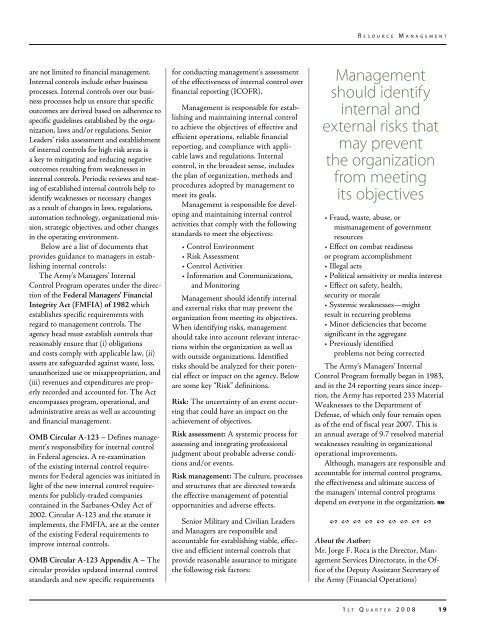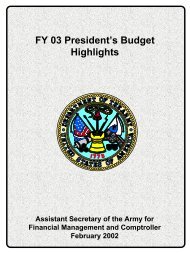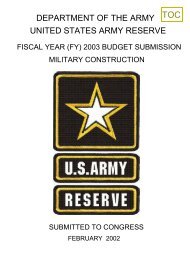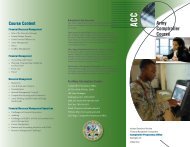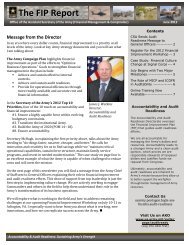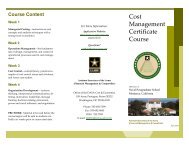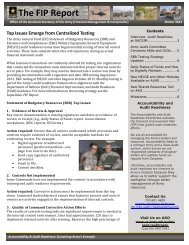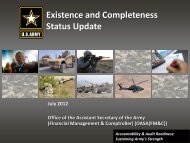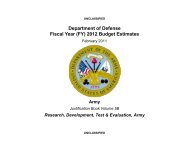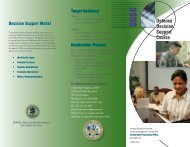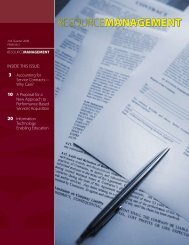inside this issue: - Army Financial Management - U.S. Army
inside this issue: - Army Financial Management - U.S. Army
inside this issue: - Army Financial Management - U.S. Army
Create successful ePaper yourself
Turn your PDF publications into a flip-book with our unique Google optimized e-Paper software.
R e s o u r c e M a n a g e m e n tare not limited to financial management.Internal controls include other businessprocesses. Internal controls over our businessprocesses help us ensure that specificoutcomes are derived based on adherence tospecific guidelines established by the organization,laws and/or regulations. SeniorLeaders’ risks assessment and establishmentof internal controls for high risk areas isa key to mitigating and reducing negativeoutcomes resulting from weaknesses ininternal controls. Periodic reviews and testingof established internal controls help toidentify weaknesses or necessary changesas a result of changes in laws, regulations,automation technology, organizational mission,strategic objectives, and other changesin the operating environment.Below are a list of documents thatprovides guidance to managers in establishinginternal controls:The <strong>Army</strong>’s Managers’ InternalControl Program operates under the directionof the Federal Managers’ <strong>Financial</strong>Integrity Act (FMFIA) of 1982 whichestablishes specific requirements withregard to management controls. Theagency head must establish controls thatreasonably ensure that (i) obligationsand costs comply with applicable law, (ii)assets are safeguarded against waste, loss,unauthorized use or misappropriation, and(iii) revenues and expenditures are properlyrecorded and accounted for. The Actencompasses program, operational, andadministrative areas as well as accountingand financial management.OMB Circular A-123 – Defines management’sresponsibility for internal controlin Federal agencies. A re-examinationof the existing internal control requirementsfor Federal agencies was initiated inlight of the new internal control requirementsfor publicly-traded companiescontained in the Sarbanes-Oxley Act of2002. Circular A-123 and the statute itimplements, the FMFIA, are at the centerof the existing Federal requirements toimprove internal controls.OMB Circular A-123 Appendix A – Thecircular provides updated internal controlstandards and new specific requirementsfor conducting management’s assessmentof the effectiveness of internal control overfinancial reporting (ICOFR).<strong>Management</strong> is responsible for establishingand maintaining internal controlto achieve the objectives of effective andefficient operations, reliable financialreporting, and compliance with applicablelaws and regulations. Internalcontrol, in the broadest sense, includesthe plan of organization, methods andprocedures adopted by management tomeet its goals.<strong>Management</strong> is responsible for developingand maintaining internal controlactivities that comply with the followingstandards to meet the objectives:• Control Environment• Risk Assessment• Control Activities• Information and Communications,and Monitoring<strong>Management</strong> should identify internaland external risks that may prevent theorganization from meeting its objectives.When identifying risks, managementshould take into account relevant interactionswithin the organization as well aswith outside organizations. Identifiedrisks should be analyzed for their potentialeffect or impact on the agency. Beloware some key “Risk” definitions.Risk: The uncertainty of an event occurringthat could have an impact on theachievement of objectives.Risk assessment: A systemic process forassessing and integrating professionaljudgment about probable adverse conditionsand/or events.Risk management: The culture, processesand structures that are directed towardsthe effective management of potentialopportunities and adverse effects.Senior Military and Civilian Leadersand Managers are responsible andaccountable for establishing viable, effectiveand efficient internal controls thatprovide reasonable assurance to mitigatethe following risk factors:<strong>Management</strong>should identifyinternal andexternal risks thatmay preventthe organizationfrom meetingits objectives• Fraud, waste, abuse, ormismanagement of governmentresources• Effect on combat readinessor program accomplishment• Illegal acts• Political sensitivity or media interest• Effect on safety, health,security or morale• Systemic weaknesses—mightresult in recurring problems• Minor deficiencies that becomesignificant in the aggregate• Previously identifiedproblems not being correctedThe <strong>Army</strong>’s Managers’ InternalControl Program formally began in 1983,and in the 24 reporting years since inception,the <strong>Army</strong> has reported 233 MaterialWeaknesses to the Department ofDefense, of which only four remain openas of the end of fiscal year 2007. This isan annual average of 9.7 resolved materialweaknesses resulting in organizationaloperational improvements.Although, managers are responsible andaccountable for internal control programs,the effectiveness and ultimate success ofthe managers’ internal control programsdepend on everyone in the organization.2 2 2 2 2 2 2 2 2About the Author:Mr. Jorge F. Roca is the Director, <strong>Management</strong>Services Directorate, in the Officeof the Deputy Assistant Secretary ofthe <strong>Army</strong> (<strong>Financial</strong> Operations)1 s t Q u a r t e r 2008 19


